
Gen Alpha is predicted to soon become a core consumer group, driving significant changes in the economy and emerging as a highly promising target audience for brands.
According to McCrindle Research, around 2.6 million children are born every week worldwide, and the Gen Alpha population is expected to exceed 2 billion by the end of 2024. Gen Alpha, or Generation Alpha, is predicted to soon become a core consumer group, driving significant changes in the economy and emerging as a highly promising target audience for brands.
According to a report by DKC, Gen Alpha in the U.S. is estimated to spend approximately $2,340 per year on themselves. The volume of consumer goods attributed to this generation is expected to grow as they gain full autonomy over their purchasing decisions in the future. At present, their influence on consumption is primarily reflected through the purchasing behavior of their parents, mainly from Generation Y. Statistics show that about 49% of Gen Alpha parents are influenced by their children's opinions when making household purchasing decisions.
Meanwhile, Gen Alpha stands out as a generation that grows up alongside technology, much like Gen Z. From birth, their access to technology has been entirely different from previous generations. According to McCrindle Research, items such as the Nokia 1100, landline phones, DVDs, CDs,... have largely disappeared from their world, replaced by iPhones, Apple Watches, AI, 5G,.... From an early age, Gen Alpha has been exposed to emerging technologies as well as social media platforms. As a result, they are often referred to as “digital citizens,” developing in tandem with technology.
Therefore, social media platforms represent a promising space for brands to observe and monitor this generation in a more direct and visual manner. So, what is Gen Alpha in Vietnam doing on social media and what are their defining characteristics? Are there any similarities or differences among Gen Alpha, Gen Y and Gen Z that brands should pay close attention to? Let’s explore more about Gen Alpha in this article!
In addition to insights on Gen Alpha, Buzzmetrics also provides a wide range of market reports across various industries and target customer segments. You can explore more in our Market Insight Library.

Generation Alpha (Gen Alpha) is a demographic term coined by Mark McCrindle to describe children born between 2010 and 2024. He explained that the reason behind the name is that Gen Alpha represents the first generation of the 21st century, a beginning of something new, rather than a return to the old. Therefore, there was no reason to cycle back to the letter A in the Latin alphabet as with previous generations. Hence, the name “Alpha” was chosen, it is the first letter of the Greek alphabet (α), symbolizing the beginning of a new era.
In 2010, the birth year of Gen Alpha also marked the launch of the first iPad and the official debut of Instagram. This is a generation that grows up with technology, able to access information quickly, and is shaped by progressive lifestyles, mindsets, and perceptions.
Because Gen Alpha has been using social media from a very young age, their thoughts and perspectives are also expressed through social media. The Gen Alpha group, aged 9 to 13, already has an independent voice on social media.
.png)
Gen Alpha has established an independent voice on social media early on. Their interaction style online shares many similarities with both Gen Z and Gen Y, as all three generations enjoy engaging through comments on fanpages and online groups. Among these, fanpages see the highest interaction rates (73.9% for Gen Alpha, 80.7% for Gen Z, and 64.4% for Gen Y).
However, when examining discussion behavior in more detail, each generation possesses its own distinct characteristics. Specifically, Gen Alpha and Gen Y tend to prefer creating content on social media, in contrast, Gen Z is more inclined to follow existing content.
(+) On personal pages, Gen Alpha and Gen Y tend to create original posts more often, while Gen Z prefers to comment on or share posts from other platforms. If one tries to understand Gen Z’s lifestyle based solely on their personal pages, it may be difficult, whereas the opposite is true for Gen Alpha and Gen Y.
(+) In groups, Gen Alpha and Gen Z mainly prefer to engage through comments. For Gen Y, in addition to commenting, creating their own posts is also a common form of interaction.

At first glance, Gen Alpha might seem to share similar discussion platforms with Gen Z. However, the top fanpages that attract the most engagement from Gen Alpha are quite different. Specifically, in addition to general information pages like “Cao thủ” and “Theanh28 Entertainment”, Gen Alpha also actively engages in discussions on pages focused on love topics (Luv Sad) and gaming (“Liên Minh Huyền Thoại: Tốc Chiến”). Moreover, the top five most popular discussion channels among Gen Alpha do not include astrology-themed pages, unlike those favored by Gen Z.
As for Gen Y, their interests are not as unified as those of Gen Alpha and Gen Z, but rather dispersed across different subgroups. However, social news pages still attract significant attention across most of these groups, notably “Chửi Thuê”, “Theanh28 Entertainment” and “Hóng Hớt Showbiz”,...

Although Gen Alpha has only recently joined social media, data collected from 300 Facebook discussions shows some of their key interests. Similar to Gen Z, Gen Alpha prioritizes three main topics: emotions, memes, and idols. In contrast, the topics that Gen Y is interested in are quite different from those of Gen Alpha and Gen Z. This generation is more segmented into smaller groups with varied interests. For instance, single individuals tend to focus more on social news or romantic relationships, while those with children are primarily concerned with parenting topics.
Delving deeper into the data reveals an interesting insight, although Gen Alpha is still of school age, discussions related to education account for only 7.3%.
(+) Romantic Topics: Among Gen Alpha, romantic topics receive the most attention. Discussions often revolve around finding a partner, expressing emotions, and raising questions about love. For instance: "Why are we online but not texting each other?" or "Once you genuinely like someone, it's hard to stop..."
(+) Meme Topics: Meme remain a hot topic for both Gen Z and Gen Alpha. However, each generation has distinct preferences. Gen Alpha prefers using meme that feature screenshots of text messages and real people. In contrast, Gen Z tends to favor animal meme and meme from iconic animated series like Tom & Jerry, as well as Disney and Ghibli films.
.png)
Gen Alpha has already begun making their first moves on social media. In the next 3-5 years, they are expected to become an important customer group for brand development, thanks to their active presence on social platforms.
This customer group will share many similarities with Gen Z, as both generations grew up alongside technological advancements. However, the data reveals some distinct differences in the platforms and discussion topics favored by each generation, reflecting their unique interests and characteristics.
Most members of Gen Alpha are being raised by parents from the Millennial and Gen Z. Discussions around the topic of parenting from these two generations reveal more open-minded and distinct perspectives compared to previous generations. This suggests that Gen Alpha’s values, interests, and ways of self-expression will carry many unique traits.
Today, Gen Alpha has become a key customer segment for several industries. As a result, brands are already beginning to research and monitor the behavior and psychology of this generation, especially on social media in order to take timely and appropriate steps to stay ahead.


For a long time, Millennials have been considered the main consumer force by brands due to their strong purchasing power and continuous growth over the years. However, this generation is now showing signs of being caught up by a completely new generation: Gen Z. According to Nielsen, by 2025 in Vietnam, Gen Z is expected to reach 15 million people and account for 30% of the consumer base.
Even now, brands tend to focus more on Millennials and there is still a lack of research on Gen Z. When it comes to Gen Z, brands often do not have a clear image, instead associating the generation with keywords like young, creative and active on social media. However, Gen Z’s actual behavior on social media differs from how brands currently perceive them. So, what is Gen Z really like? Let’s explore in the article below with Buzzmetrics.
The age range for Gen Z is different in each country, but most agree that this generation includes those born between 1997 and 2012. Unlike the young people of Gen X and even Gen Y, Gen Z grew up with digital technology from an early age, becoming familiar with the Internet and social media and mastering smart devices even before they could read or write. As a result, this generation is also known by various other names: iGeneration, Generation, Homeland, Net Gen, Neo-Digital Natives, Digital Natives, Pluralist Generation, Internet Generation, Centennials, Later - Millennials, Gen Wii, Zoomers, Gen-Tech,…
When mentioning Gen Z, we often think of a young group still in school and not yet financially independent, which leads to limited purchasing power and mainly influencing their parents' buying decisions rather than being the final decision-makers themselves. However, in reality, the oldest members of Gen Z are now between 24 and 27 years old. They are already working, financially capable and some have even started families of their own.
According to research by McKinsey, Gen Z currently accounts for 40% of global consumers. Additionally, Nielsen’s study titled “Generation Z - The consumers of the future” found that over 70% of surveyed Gen Z individuals reported having a significant influence on their family’s purchasing and lifestyle decisions. This includes decisions related to outdoor activities, entertainment, household items, clothing, food and beverages.
These figures highlight Gen Z as a highly promising consumer group with growing purchasing power. As a result, brands around the world are beginning to recognize that this generation is simply too important to ignore. A report by The Influencer Marketing Factory revealed that 97% of Gen Z admit that social media influences their shopping decisions. Additionally, a separate study by Statista found that 54% of Gen Z believe social media helps them discover new products more effectively than traditional online search methods.
Given these insights, it’s clear that to engage Gen Z effectively, brands must gain a deep understanding of their digital behavior, especially on social media platforms.
The digital environment has become an essential part of Gen Z’s daily life. Because of their close connection with the virtual world, brands often view Gen Z as content creators on social media, who actively express opinions or share reviews online.
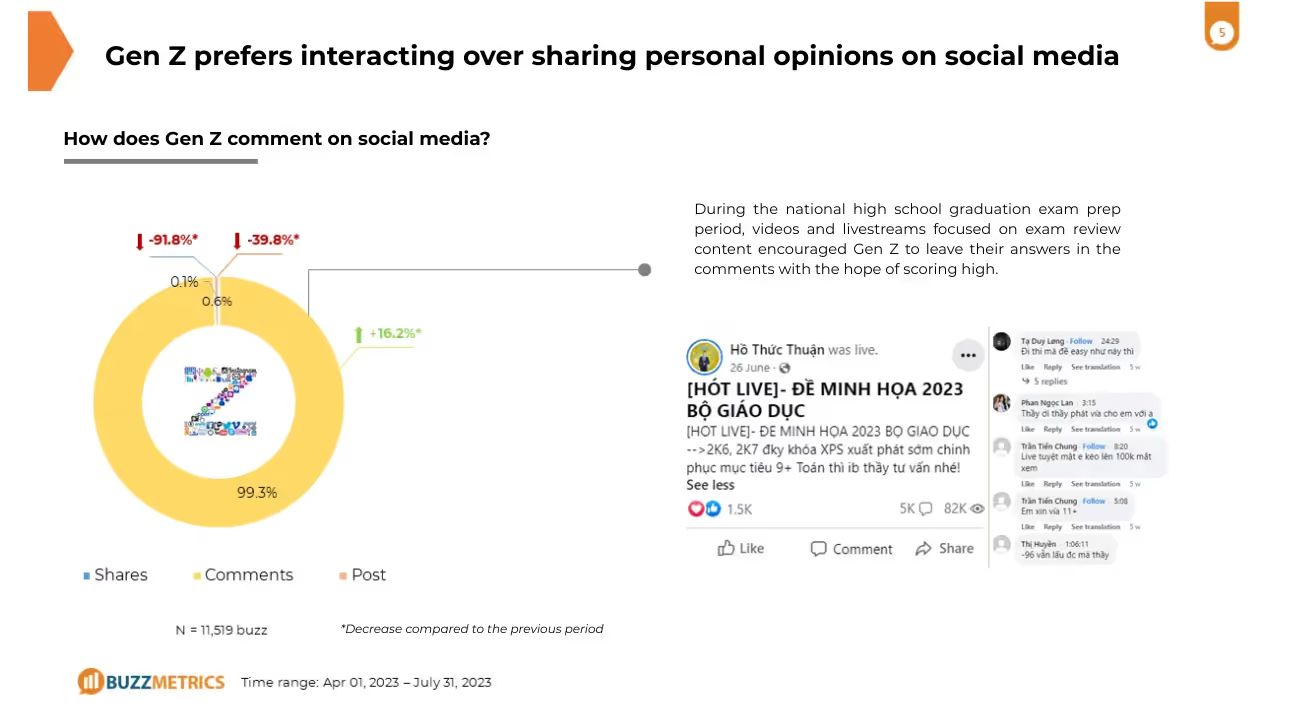
However, according to Buzzmetrics, Gen Z is more likely to engage with content more than create it. They prefer engaging with others' posts (by liking, commenting or sharing) rather than creating their own. If they do post something, it’s usually a selfie accompanied by a simple caption. Questions like “What does Gen Z care about?” or “What is their lifestyle like?” are difficult to answer just by looking at their personal pages. In contrast, older generations such as Gen X or even some Millennials are often more willing to create content, writing posts to express their opinions (about family, society, lifestyle, etc.) or to share everyday activities (like travel, leisure, shopping). Their interests and lifestyle choices are often clearly reflected on their social media profiles. This presents an interesting contrast, as older generations are often referred to as Digital Immigrants. They grew up before social media existed and are usually seen as less tech-savvy. Yet, the way they present themselves online tends to be more open than Gen Z. As a result, in order to truly understand and connect with Gen Z, brands must identify where this generation genuinely belongs in the digital space.
Key questions:
Sign up to purchase the Gen Z report here.
Gen Z is a young generation that has grown up immersed in technology and has helped expand the vocabulary of social media users. You’ll often come across comments that include quirky phrases like “dảk dảk” or “bủh bủh” - signature expressions of Gen Z’s online language. This gives the impression that any space on social media could be a buzzing discussion spot for them. However, research from Buzzmetrics shows a different side: this group tends not to share much about their personal lives through food photos or selfies with short captions. In other words, their personal profiles often appear relatively quiet, which challenges the common assumption that Gen Z is always present and vocal everywhere online. So where exactly does Gen Z really live on social media?
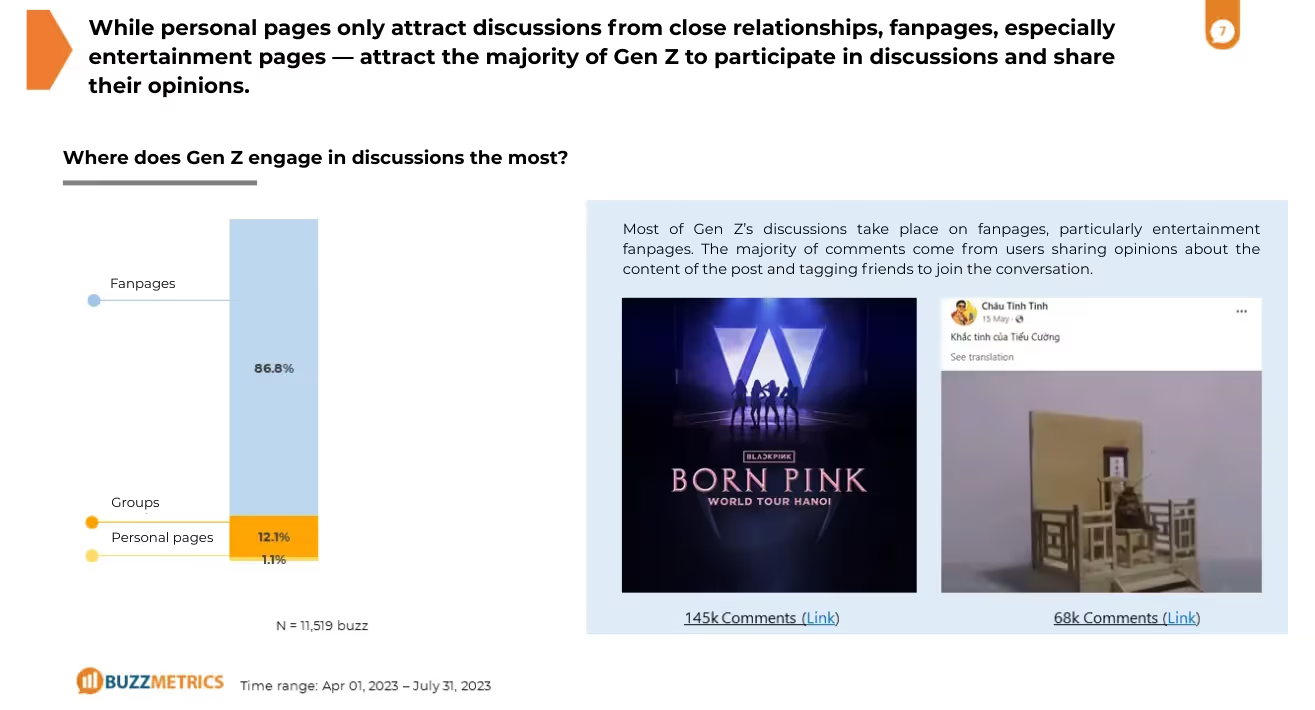
According to Buzzmetrics’ research on social media discussions, Gen Z tends to share and engage in public conversations less on their personal profiles and more on channels with a stronger community focus such as fanpage. Specifically:
Gen Z discusses differently on community pages compared to their personal pages. Compared to previous generations, Gen Z has often been portrayed by the media as a mysterious generation. This is not only because Gen Z is relatively new and less thoroughly studied, but also because their true interests can only be identified by tracking discussions in community channels. There are topics considered “exclusive” to Gen Z, most notably school and exams. Among these, content about “luck” in exams presents an opportunity for brands to explore more deeply.
In the context of exam-related stress and anxiety, the element of luck is often valued by Gen Z students, sometimes even serving as an important source of emotional encouragement. Brands can take advantage of this topic by creating spiritually themed content like “share a spoon to get high scores” to boost engagement.
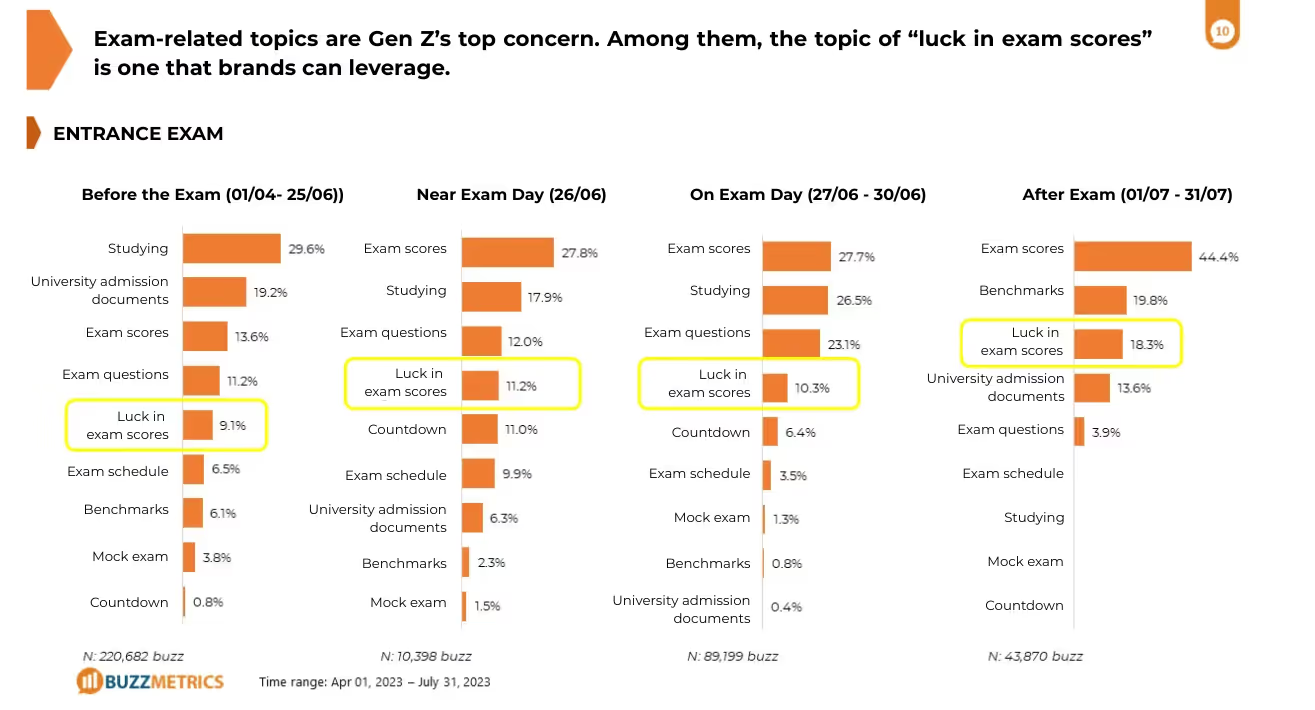
Aside from school-related topics, love and football are also subjects that Gen Z pays special attention to.
Read more: Euro 2024 through the lens of Social Listening
Key questions:
Register to purchase the Gen Z report here.
→ See also: What is target audience research?
Understanding the peak activity times of Gen Z on social media helps brands optimize post timing, run ads or organize online events to effectively reach this audience.
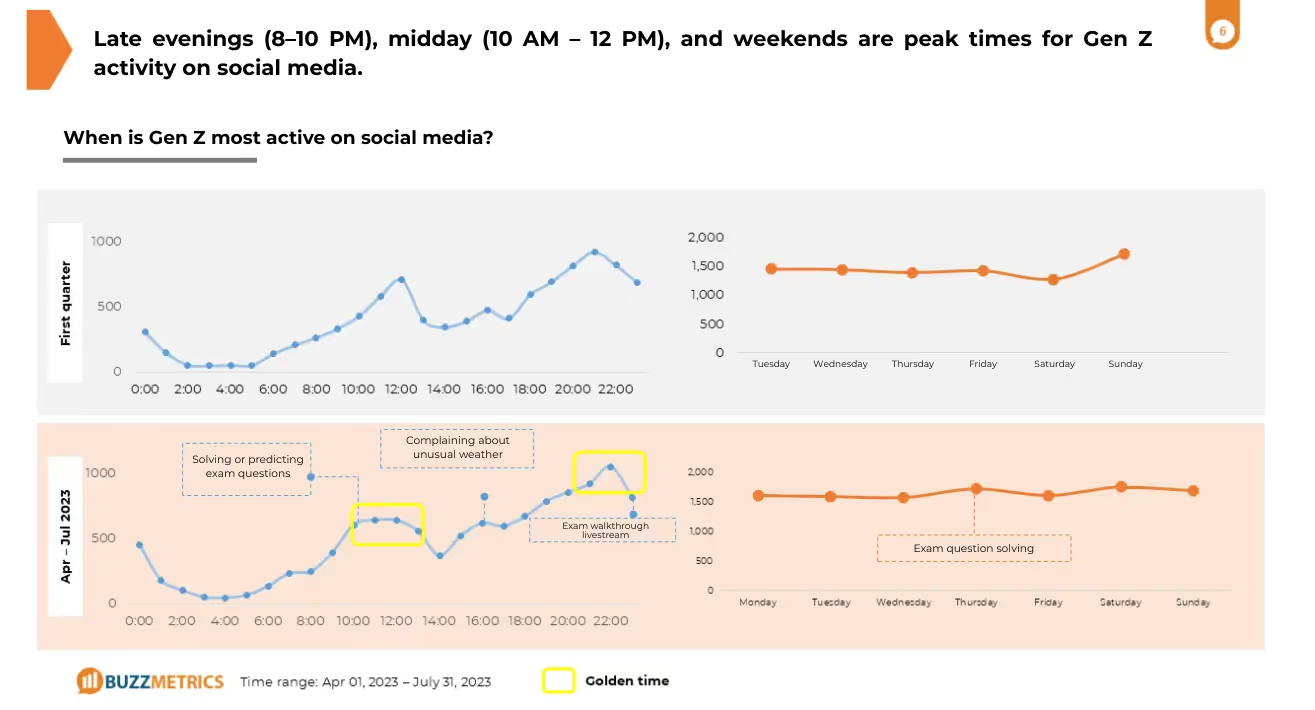
To seize opportunities and boost sales from Gen Z, brands must clearly understand the behavior of this group on social media. By choosing the right timing, creating content and products that accurately reflect what Gen Z wants, marketing campaigns will achieve greater effectiveness, leading to sustainable business growth.
Leverage the right relevant topics: Understanding and leveraging the topics that Gen Z cares about most will help brands create viral content and enhance their reach on social media. When it comes to entertainment content, the content strategy of Gimbap 178 Minh Cầu is a notable example. While the entire F&B industry focuses on posting food photos, Gimbap 178 Minh Cầu skips that trend entirely and instead emphasizes meme content - short, humorous posts with little commercial intent. Their posts still revolve around food but are presented from quirky, humorous angles that attract Gen Z. The brand also posts consistently at 5 PM. This regular posting of memes helped build a habit among Gen Z of "checking in" on social media at that time, thereby boosting interaction frequency with the brand.

_11zon.avif)
Following a disruptive 2021 caused by the pandemic, the banking industry has witnessed an emergence of new trends. One of the most notable in recent times is the shift toward youth-oriented content to target Gen-Z - a key customer segment with strong potential in the future.
Following a disruptive 2021 caused by the pandemic, the banking industry has witnessed an emergence of new trends. One of the most notable in recent times is the shift toward youth-oriented content to target Gen-Z - a key customer segment with strong potential in the future. Currently, when examining the share of social media discussions across age groups, Gen Y remains the most active generation while Gen-Z ranks second with 12.9%. However, Gen-Z is still in the early stages of becoming key purchasing decision-makers and their role in the banking industry is expected to grow significantly. Their distinct behaviors on social media also call for appropriate communication strategies. As a result, understanding Gen-Z and how competitors are adapting to reach them has become a strategic priority for banks. In this article, Buzzmetrics will provide marketers with the latest data and insights to navigate this emerging trend effectively.
In addition to exploring the youth-oriented content trend, Buzzmetrics also conducts research on various other topics within the banking industry. To gain a comprehensive view of this industry over the past period, please refer to the full report here.
In Buzzmetrics’ general report on Gen-Z, one notable behavior of this group is their tendency to share opinions in communities made just for them. Although they still participate in discussions across various platforms, their comments often do not reveal clear interests or expectations. This behavior is also reflected in conversations about the banking industry, posing a challenge for brands aiming to engage them. Specifically, when analyzing Gen-Z's discussion sources related to banking, official bank fanpages create less buzz than Gen-Z-focused communities and pages. Additionally, comments on banking fanpages do not show significant differences between Gen-Z and other segments: Most of Gen-Z’s comments primarily revolve around service reviews, brand quality,...
_11zon.avif)
However, analysis of Gen-Z-focused communities and pages reveals a completely different picture. On these platforms, Gen-Z begins to speak more openly about their “unique” expectations such as having lucky account number, app with features that support financial management and ATM access that is widely available,... Therefore, reaching Gen-Z requires greater effort than with other segments, as Gen-Z has higher expectations and tends to engage more actively on niche platforms.
From a branding perspective, several banks have started focusing more on communication efforts to reach Gen-Z. This shift in brand strategy is reflected in three key elements: (1) New features, (2) Creative content and (3) Communication format. In terms of features, to attract young users, many banks have enhanced their e-banking apps beyond basic functions such as payments and transfers, integrating more playful utilities. For example, MB Bank introduced a horoscope feature within its app, while TPBank integrated a virtual lucky money feature during Lunar New Year,... These additions have received positive feedback from young users, who have expressed interest in even more unique and entertaining features such as astrology maps, look up prayer guides, feng shui, daily horoscopes,...
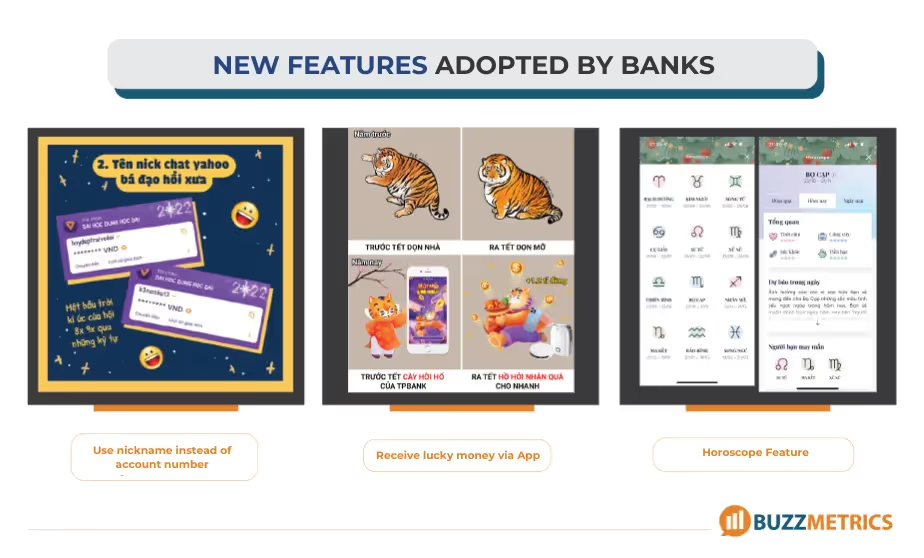
In terms of content creation, banks are showing a stronger ability to catch “trend”. Popular topics in the music scene (such as viral songs like "Mang Tiền Về Cho Mẹ" or "Si Tình") are cleverly repurposed by brands as creative material for social media posts. Additionally, many banks are now paying more attention to customizing their apps for specific occasions (during the Christmas season, E-Banking interfaces may be decorated with Christmas trees,...).
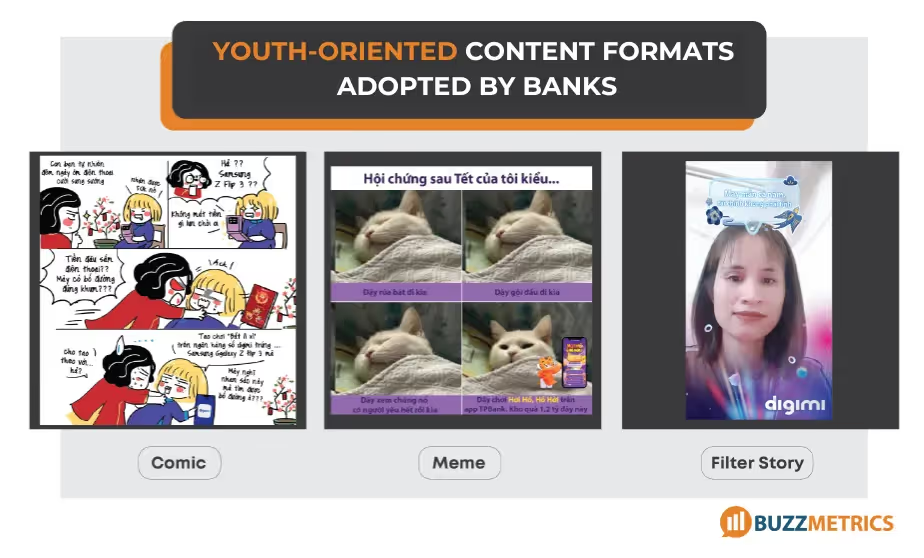
The communication format used by banks have also seen significant changes. In the past, most bank posts were lengthy and focused mainly on promoting products or outlining promotional details. Brands today are becoming more creative in embedding their campaigns into comic-style narratives, using language that feels more casual and infused with Gen-Z flavor (use social slang like “khum” or “sin lũi”,...). In addition to comic-style, brands have also introduced filter story and meme - formats that are especially favored by Gen-Z audiences.
Gen-Z is a future customer segment across various industries, including banking. As a result, brands that succeed in establishing early connections with Gen-Z are more likely to secure a long-term competitive edge. In the banking industry in particular, several brands have started creating youth-oriented content and are receiving positive feedback from Gen-Z. With an industry facing intense social media competition like banking, these brands are demonstrating a strong ability to keep up with trends and generate more positive impact compared to others.


This is one of a series of articles that show the real picture of how social media listening and tracking tools work, especially Buzzmetrics, a tool that is being used to track campaigns and brands.
This article will show how the data collection of social media listening and tracking tools works. We will use BuzzMetrics for demonstration. BuzzMetrics is a social listening tool for tracking campaigns and brands managed by major corporations such as Samsung, Coca-Cola, Unilever and global agencies such as Ogilvy, Maxus, Leo Burnett, Phibious, Performics... in Vietnam. Social Listening is a new business form of market research. And just like traditional market research processes, social media research also goes through five stages: 1. Data Collection - 2. Take samples - 3. Data classification - 4. Data Analysis - 5. Presentation of research report. Data collection is the first step in the process of carrying out research on social media. Social listening tools will have to build a data pool for each country they study (panels), and this could take months or even years. At the same time, for each campaign, agencies will request the addition of channels used for that campaign, such as microsites, new fanpages, which the social listening tool will have to respond to. Collecting market-wide data is necessary and allows researchers to produce trend and industry studies. There are currently two main methods for collecting data: Keywords and Sites.
COLLECTING DATA WITH KEYWORDS
This method is applied to global social networks such as Facebook, Google Plus, Youtube, Twitter, Instagram... where social listening tools connect to APIs (Application Programming Interface) of social networks and request permission to retrieve data containing keywords.
DATA COLLECTION BY SITES
It is the collection of data by site in which the sites with the data you want to collect must be listed in the system. This method helps to collect the entire data of the covered channels. The system will access the websites to be collected, click on article links, find article readings and record information of value for research effectively without affecting the websites being collected.



With the method of collecting data using sites, the system performs operations as a user when accessing the page to be collected. After clicking on the Thread, the system will copy the entire content displayed on the screen including Title, Replies, Authors, URL, etc. Then the system will return to each page as soon as possible to find a new thread and a new reply for the old thread. Each reply will count as 1 mention and each thread will also count as 1 mention. Therefore, a thread with 100 replies will count as 101 mentions, or 101 consumer opinions.
- Site structure changes
- Site blocking: automatic collection of data, in case of misuse of resources of websites, will be blocked by admin
- Site down: Unable to access to collect data when the page is in maintenance or problems occur
- Problems come from Internet channel
Building a list of all forums, e-newspapers and fanpages in Vietnam is a long process. That's why foreign Social Listening Tools often lack data due to insufficient site collection, or when faced with one of the above problems, there is no human resources to deal with it immediately. In the process of ensuring complete data for campaigns and brands, social listening tools such as Buzzmetrics have to use a human resource department that applies a variety of computer-assisted methods to check whether data on critical channels is being collected enough or not. This is the difference between free tools and all-inclusive social listening solutions, which is the guarantee of complete data for customers. Social listening technology, as well as search engine technology, is a model that aggregates market data. A social listening tool must store data for at least two years for research purposes. The pressure to store and process data also increases over time, so the investment in hardware infrastructure systems is also huge and continuous.

